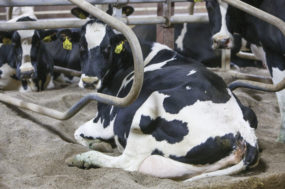The number of niche-market dairy and beef products are expanding, with individual companies making various label and marketing claims. One of the fastest-growing markets is “grassfed” milk, attracting producers and consumers, and premium prices.
Although similar, organizations and companies establish their own unique set of production standards for grassfed dairy and beef. Leading the charge are the American Grassfed Association (AGA), organic companies and regional organic certification associations, such as Pennsylvania Certified Organic and the New York-Northeast Organic Farming Association.
In all cases, grassfed products are sourced from farmers feeding 100 percent forages (fresh and dried), with no grain supplementation. In virtually all cases, animal confinement, use of hormones, ionophores or antibiotics are prohibited.
From there, however, individual standards and label claims may diverge. According to the AGA, the rapid growth of the grassfed dairy segment and the consequent proliferation of grass- and pasture-based marketing claims pose a challenge for dairy producers, retailers and consumers.
Earlier this year, AGA convened a meeting to discuss mutual concerns about practices, standards, protection of legitimate claims and avoidance of consumer confusion about grass-based products.
AGA’s tent is bigger and goes beyond organic. It is seeking to develop standards that bridge the gap between grassfed and organic grassfed products. After its creation in 2003, AGA worked with USDA for about six years before launching grassfed standards and a certification program in 2009. It has its own label to identify certified grassfed products.
The goals of the AGA meeting, held in March in Denver, Colorado, were to determine the potential for agreement on unified standards for grassfed dairy products, while protecting the integrity of product identities. Discussions centered on topics including animal health and nutrition, transparency of practices and claims, holistic land and soil management, support and validation for producers, and building on the “certified organic” standard while providing a bridge with non-organic grassfed claims.
Meeting participants included representatives from organic companies, third-party certification associations, producers, manufacturers, a major retailer and veterinarians.
Meeting outcome
Two working groups have formed, one of which will draft a merged standards document for further discussion. The other group will seek to clarify options for market integrity.
It’s too soon to say when the new grassfed standards and certification will appear in the marketplace, according to Marilyn Noble, AGA communications director.
“We feel this meeting was an important first step to develop a clear and definable industry standard that will encourage producers to develop grassfed dairy programs and also to provide assurance to consumers when they see the term ‘grassfed’ on a carton of milk or other dairy products,” said Don Davis, chair of AGA’s standards and certification committee.
Organic Valley adding farmers
The grassfed dairy market is small, but growing. The largest organic cooperative in the U.S., Organic Valley, recently added 17 northeast U.S. dairy farmers to increase production of its Grassmilk products, building its stable of Grassmilk farms to 81. The newest additions are connected with a new milk route winding from Canastota, New York to Gillet, Pennsylvania. It is then transported to Mountainside Farms in Roxbury, New York, where it is packaged.
Organic Valley trademarked the Grassmilk term in 2011, and began producing Organic Valley Grassmilk milk in northern California’s Humboldt County in 2012. Production was expanded to Wisconsin in 2013, with distribution going national.
Organic Valley Grassmilk Yogurt was launched in 2015. According to the cooperative, the “grassfed” yogurt category is experiencing 82 percent dollar growth, more than three times the growth of yogurt without the “grassfed” claim.
While the conventional dairy market is seeing prices decline, Organic Valley’s website lists regional, 12-month 2016 base prices for milk sourced from grass-fed farms ranging from $36.30 per hundredweight in the Midwest to $40.80 per hundredweight in New England.
Read AGA takes the lead on new industry-wide grassfed dairy standard. PD

-
Dave Natzke
- Editor
- Progressive Dairyman
- Email Dave Natzke



